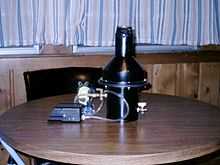Lucas cell

A Lucas cell is a type of scintillation counter.[1] It is used to grab a gas sample, filter out the radioactive particulates through a special filter and then count the radioactive decay. It is frequently used to measure radon gas concentrations. The inside of the gas chamber is coated with silver-activated zinc sulfide or ZnS(Ag) that scintillates or shines when struck by alpha particles. A photomultiplier tube at the top of the chamber counts the photons and sends the count to the data logger or counter.
Radon itself is an inert gas. Its danger lies in the fact that it is radioactive and its radioactive daughters accumulate in the dust of enclosed areas. The radon daughters may lodge in the lungs and bombard them with alpha and beta radiation.
See also
References
- ↑ Lucas, Henry (1957). Review of Scientific Instruments 28 (9): 680–683. Bibcode:1957RScI...28..680L. doi:10.1063/1.1715975.
External links
- http://www.albert-cordova.com/lucas/lucascell.htm
- http://www.blackcatsystems.com/GM/articles/radon_thoron.html
- http://enhs.umn.edu/hazards/hazardssite/radon/radonmeasure.html
- http://www.sciencedirect.com/science?_ob=ArticleURL&_udi=B6TJ0-4CBDB5C-1&_user=10&_coverDate=12%2F31%2F2004&_rdoc=1&_fmt=high&_orig=search&_origin=search&_sort=d&_docanchor=&view=c&_acct=C000050221&_version=1&_urlVersion=0&_userid=10&md5=1ba2f4b547066de782ebb7c774375b78&searchtype=a
- http://www.finderschoice.com/radon/instruments.php